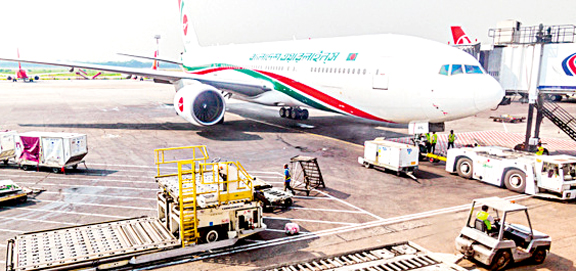DE News Desk :
Bangladesh marked a new chapter in its export capabilities on Sunday as the country’s first dedicated freighter flight departed from Sylhet’s Osmani International Airport, following India’s sudden suspension of third-country transshipment facilities.
In a symbolic moment, water cannons saluted the chartered Airbus A330-300 freighter operated by Galistair Aviation as it took off, carrying 60 tonnes of ready-made garments (RMG) to Zaragoza, Spain, via Dubai.
Biman Bangladesh Airlines is providing ground-handling services for the new cargo operations.
“This new cargo operation strengthens our export infrastructure and will help bridge the gap created by India’s transshipment ban,” said Commerce and Civil Aviation and Tourism Adviser Sk. Bashir Uddin at the inaugural ceremony.
The adviser emphasized that the government had swiftly launched multiple initiatives to tackle the challenges posed by the Indian decision.
He also announced plans to revise civil aviation and ground-handling tariffs to make air cargo services more cost-competitive.
“We are determined to make cargo transport cheaper than transshipment through India,” he said.
Bangladesh’s Ambassador to Mexico, M. Mushfiqul Fazal Ansarey, and Civil Aviation and Tourism Secretary Nasreen Jahan were present as special guests.
Chairman of the Civil Aviation Authority of Bangladesh (CAAB), Air Vice Marshal Md Monjur Kabir Bhuiyan, presided over the event.
“We are no longer dependent on others. From Sylhet’s soil, our goods will now reach the global market directly,” said Ambassador Ansarey, hailing the launch as a major step forward for Bangladesh’s export industry.
CAAB Chairman Bhuiyan added that cargo operations from Chattogram Airport will begin soon, followed by flights from Cox’s Bazar Airport starting in June.
Initially, two chartered freighter flights will operate weekly from Sylhet, with frequency to be adjusted based on demand.
Bhuiyan also highlighted ongoing efforts to expand capacity at Hazrat Shahjalal International Airport (HSIA) ahead of the opening of its Third Terminal, saying, “Our existing infrastructure will soon be able to handle two to three times more cargo volume.”
The newly upgraded cargo terminal in Sylhet already boasts significant capacity, and efforts are underway to encourage local exporters to utilize Osmani International Airport for global shipments.
In addition to Sylhet and Chattogram, the Third Terminal at HSIA is expected to triple Bangladesh’s export cargo capacity from 200,000 tonnes to 546,000 tonnes annually, with a dedicated 36,000-square-metre cargo zone.
India’s abrupt decision earlier this month to revoke a four-year arrangement allowing Bangladeshi goods—primarily garments—to transit through airports like Kolkata and Delhi has strained Bangladesh’s export sector.
According to the Bangladesh Freight Forwarders Association (BAFFA), nearly 600 tonnes—or 18 percent—of the country’s weekly garment air exports were routed through India.
Currently, Bangladesh exports around 3,400 tonnes of garments by air each week. HSIA’s cargo village, originally designed for 300 tonnes per day, often handles over 1,200 tonnes during peak periods.
Major international airlines such as Emirates, Cathay Pacific, Qatar Airways, Turkish Airlines, and Ethiopian Airlines already operate dedicated cargo flights from HSIA, and the new freighter routes are expected to further strengthen Bangladesh’s position in global trade.

